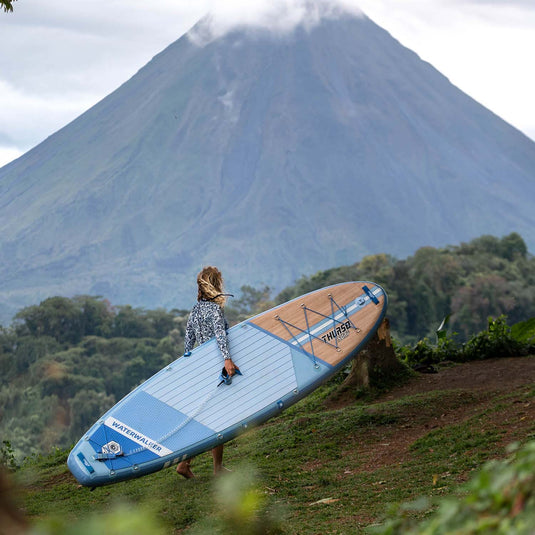Paddleboard yoga, often called SUP yoga (SUP stands for stand-up paddling), is a fascinating fusion of two popular activities. It combines the meditative calm and body control of yoga with the refreshing water environment and the playful challenge of paddleboarding. If you've ever been curious to see how it works, you've come to the right place.

What is SUP Yoga and why should I try it?
Imagine practicing yoga outdoors, surrounded by the gentle lapping of water, with the sky as your studio ceiling. SUP yoga is exactly that. It moves your yoga mat from solid ground to a floating paddleboard.
Health benefits of SUP yoga
Research has repeatedly shown that spending time in nature can improve mood and reduce stress.
- Improved balance : Nothing trains your balance better than an unstable surface. Every movement, no matter how small, requires compensation, which greatly strengthens your core muscles and your balance.
- Increased core strength : The constant demand to maintain balance continuously activates your core muscles.
- More intense body awareness : You will be more mindful of your movements, as any careless action can lead to an involuntary bath.
- Connecting with nature : Practicing yoga in nature is grounding and calming. On the water, this experience is even more intense.
- Stress relief and relaxation : The gentle rocking of the water and the fresh air contribute significantly to relaxation. Lying on the water in Shavasana (final relaxation) at the end of the practice is an unforgettable experience.
- Fun and cooling : Yes, you'll probably fall into the water! But that's part of the fun and a welcome relief on warm days.

What do you need for SUP Yoga?
Paddleboard
A stable board with a non-slip surface is ideal. Inflatable boards (iSUPs) are often well suited for yoga, as they are slightly more flexible and often have a wider, more stable shape. Inflatable all-around boards from 10 ft 6 in. are suitable for yoga sessions on the water.
paddle
Any adjustable SUP paddle is ideal for SUP yoga – it's best to wrap the leash around the paddle a few times to secure it and let it float in the water behind the paddle.
Leash (safety leash)
Indispensable to prevent your board from drifting away if you fall into the water.
Life jacket/PFD (optional but recommended)
Life jackets or buoyancy aids are used in various water sports and should also be part of your SUP equipment. Depending on local regulations and your swimming ability, safety comes first!
Anchor (optional, but helpful)
A lightweight folding anchor or a weight on a line will keep your board in place, especially when you're concentrating on a pose or lying in the water for a long time.
Suitable clothing
Swimwear or quick-drying activewear. Avoid cotton, as it absorbs water and becomes heavy. Dress appropriately for the weather—wetsuit pants can also be helpful on cooler days.
Sun protection
Waterproof sunscreen, sunglasses (with strap!) and possibly a cap.
Water
Water is essential for all outdoor activities! Yoga tends to work up a sweat, so water is essential for any form of yoga. Remember to bring a water bottle and stay hydrated while practicing SUP yoga on the water.
How to start with SUP Yoga: First steps
- Choose the right spot : Look for calm water. A lake, a slow-flowing bay, or a sheltered area by the ocean are ideal. Avoid strong winds, currents, or boat traffic.
- Prepare your board : Pump up your board and attach the leash to your ankle or calf (at the D-ring at the rear of the board).
- Entering the water : Get into knee-deep water with your board. Place your paddle across the board in front of you. Step onto the board with your knees on, positioning yourself in the middle (the carrying handle is often a good indicator).
- Get used to the board : Kneel on it for a bit, feel the slight rocking. Then paddle on your knees or standing up to your yoga spot. Practice standing up and sitting down on solid ground or at least shallow water first.
- Find your center : For your yoga practice, position yourself in the center of the board, ideally over the carrying handle, as this is the most stable point. You can store your paddle under the bungee strap or secure it with the anchor.
Start slowly: Start with simple seated poses (cross-legged, long-legged). Then move on to kneeling poses (crouching position, child's pose). - Standing poses : When you feel confident, try standing poses. Always position your feet wide on the board for stability. Keep your knees slightly bent.
- Focus (Drishti) : Choose a fixed point on the horizon or the bow of your board to focus your gaze on. This helps immensely with balance.
- Slow movements : Perform all transitions and postures slowly and deliberately. Avoid jerky movements.
- Fall over and laugh : It's completely normal and part of the experience! If you fall, try to bounce away from the board to avoid injury. The water provides a soft landing. Getting back on the board is a good exercise in itself.

Simple postures for beginners on the SUP
Sitting postures : Cross-legged pose (Sukhasana), long seat, boat pose (Navasana) – incredibly demanding for the torso!
On the knees : Tabletop pose, Cat/Cow pose (Marjaryasana/Bitilasana), Child's pose (Balasana).
Standing poses (with caution) : Downward-Facing Dog (Adho Mukha Svanasana) – feet and hands must be firmly planted on the board! Warrior II (Virabhadrasana II), Tree Pose (Vrikshasana) – a real balance challenge!
Relaxation : Shavasana (final relaxation) – simply lie on your back or stomach, hands and feet relaxed. The board moves gently with the water.
Safety tips
Paddleboard yoga is far more than just a workout. It's an invitation to feel the elements, gently expand your limits, and develop a deep connection with yourself and nature. It requires patience, humor, and a willingness to surrender to the flow of the water (and the plunge!).
If you're ready for a refreshing challenge for body and mind, hop (carefully) on a paddleboard and discover the magic of SUP yoga. Have fun and balance on the water!



